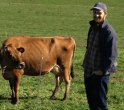Focus on Agriculture in the Champlain Valley and Beyond
 By Jeff Carter, UVM Ext. Agronomist
By Jeff Carter, UVM Ext. Agronomist
Champlain Valley Crop, Soil & Pasture Team Leader
We all have learned a lot about using no-till and cover crop farming practices on clay soils over the past few years, and feel good about it because improving soil health for the future really is important. If not, I don’t think you would be farming.
But the fabric of agriculture is a bit tricky as one side pulls the covers off the other, then back, and over and over. Field practices to improve crop yields and water infiltration come back to bite us with reports of fear that this will increase the amount of dissolved phosphorus in the soil, which is exactly what you want for better crops, but not if it leaks out and pollutes Lake Champlain. Now the quilt comes off again and it becomes apparent that the environmental damage may be increased by activities like improving soil health with tile drainage, no-till planting, even cover crop roots that go down into the soil to reduce compaction. All are field practices we promote with confidence that this will solve the “problem”.
Now in a recent report from Farm Journal, Field Agronomist Ken Ferrie discusses how improving soil health increases the concerns about nitrate and water-soluble phosphorus losses down through the soil. But let’s not stop with that part of the equation. This is not a bad thing; it’s just that now farmers need to be even more aware of how their field management practices impact their P losses. And how important the work we do at Extension to compare different cropping system components helps farmers decide what balance of tillage and crop types is right for their farm. One response is to stop if we are afraid; the other is to carefully move ahead with calculated confidence that we are making a positive difference, measure the effect, recognize some new problems, and move ahead.

The Required Agriculture Practices are now here, and we will have a lot of “quilt pulling” as changing one thing like – requiring buffers along ditches – may trigger responses that are counter-productive like installing tile in the whole field and burying those ditches. Which way is better? I’m not sure; just that when the quilt gets pulled off me, I pull back. Switching to no-till corn is a proven way to help soil aggregate structure, greatly reduce soil erosion and reduce fossil fuel use. Yet the reaction is that preferential flow paths through the soil form as a conduit to move manure and P too fast through the soil matrix.
The Vermont Tile Drainage Advisory Group report has been submitted to the Agencies of Agriculture and Natural Resources, and will inform the Secretaries for their joint report to the legislature in January. I participated on that advisory group and the discussions highlighted that these issues are not simply good and bad. Every action, like improving soil drainage, forces a conflict between a current farm business and family sustainability, and the cost of water quality remediation for past indiscretions in our lake that we are faced with fixing.
The only way that we will be able to keep a reasonable perspective is for everyone (both sides of the bed) to continue to be vigilant to maintain a good balance of using our land resources to make money, but keep the water clean. This will never end, as the challenges of farming in Vermont are made more difficult with awareness of how a little P makes such a big problem in the Lake.
I heard a great quote: “there are no wrong turns on the journey, just course corrections when we figure out where we want to go next.” I think we should be focused on learning how to make the best next moves, together, for farming practices that will help us meet the P reduction goals of the Vermont Clean Water Act. I don’t agree with the folks who want to curtail the dairy industry in Vermont with hopes that a different farming model or land use is better. Get active in your local farmer watershed group (there are three in Vt.), come to conferences and workshops we offer to get better at these decisions, speak up so the general public and legislative policy makers hear your voice.
Have a question for Jeff? He can be reached at 802-388-4969 ext. 332 or jeff.carter@uvm.edu
Are you currently receiving our newsletters via e-mail? If not, you can SUBSCRIBE HERE.
Stay updated on our events via our blogpage, or via Facebook
A pdf version of our entire newsletter can be viewed here. Our team work is funded through multiple grants and could not be accomplished without our supporters and funders.
Individual newsletter articles can be viewed on the blog below.

















